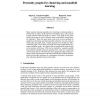Free Online Productivity Tools
i2Speak
i2Symbol
i2OCR
iTex2Img
iWeb2Print
iWeb2Shot
i2Type
iPdf2Split
iPdf2Merge
i2Bopomofo
i2Arabic
i2Style
i2Image
i2PDF
iLatex2Rtf
Sci2ools
NIPS
2004
2004
Proximity Graphs for Clustering and Manifold Learning
Many machine learning algorithms for clustering or dimensionality reduction take as input a cloud of points in Euclidean space, and construct a graph with the input data points as vertices. This graph is then partitioned (clustering) or used to redefine metric information (dimensionality reduction). There has been much recent work on new methods for graph-based clustering and dimensionality reduction, but not much on constructing the graph itself. Graphs typically used include the fullyconnected graph, a local fixed-grid graph (for image segmentation) or a nearest-neighbor graph. We suggest that the graph should adapt locally to the structure of the data. This can be achieved by a graph ensemble that combines multiple minimum spanning trees, each fit to a perturbed version of the data set. We show that such a graph ensemble usually produces a better representation of the data manifold than standard methods; and that it provides robustness to a subsequent clustering or dimensionality r...
| Added | 31 Oct 2010 |
| Updated | 31 Oct 2010 |
| Type | Conference |
| Year | 2004 |
| Where | NIPS |
| Authors | Miguel Á. Carreira-Perpiñán, Richard S. Zemel |
Comments (0)

